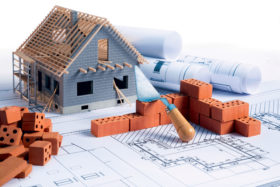
Use code BUILD for 20% off
Book here!
Use code BUILD for 20% off
Book here!There are 32 regulated companies supplying a mix of services for water and sewage supplies in England and Wales. This covers 19 regionals, five locals and eight licencees who deal with the bigger users.
These are all regulated by Ofwat, which is a non-ministerial government department established in 1989 when these services were privatised. The regulator aims to look after the consumer by ensuring good standards of customer service and acceptable pricing. In Scotland, you will deal with Scottish Water, which is a publicly-owned business.
In some parts of England and Wales, water supply and sewage collection are managed by the same company – accounting for 10 of the 19 regionals. The logic behind this link is simple. We drink very little of the water supplied to us and, consequently, in excess of 95% must therefore be taken away in sewers. The other nine are supply-only, which means sewage collection is managed by a partner firm, potentially giving you two separate monthly bills.
If you’re buying a rural plot with no history of housing then you may find getting your main services to site is going to be expensive. Even if it’s a brownfield site (ie somewhere that has been built on in the past, but not for residential use) any historic water supplies may be unreliable and are likely to be distributed through lead or corroded steel pipes.
Where you aren’t sure if there’s a supply on site then you should apply for a CON29DW Drainage and Water enquiry report, which costs around £45. This will map out the any issues for your land’s drainage and water. If there are no supplies, then at the very least it will show where the nearest recorded water main is located.
If you’re replacing an existing house then you need to investigate the type of water supply in place. Unlike gas and electricity connections, water meters (which are now increasingly the norm instead of a set monthly rate) are usually located in the pavement at the property boundary.
The water authority takes responsibility for the supply as far as the meter, but then it’s down to you to sort all pipework from the meter to your house. Modern plumbing means we’re becoming increasingly reliant on good pressure and high-water volumes, so pipes to old houses could need upgrading.
Ahead of getting in touch with your authority with a water application, gathering the following data will make the whole process easier for you:
Some authorities will give you budget guidance over the phone, but the process begins in earnest when you make a formal application for a new supply. This is usually easiest to do online.
Alternatives to the main supplyDuring the building process, if you need water quickly and you haven’t yet applied for a temporary supply, one option is to hire a water bowser. These can be mobile or static, with a mobile option being a small lorry/tanker and for static a raised tank, which in turn must be filled by a visiting lorry. In remote locations where there’s no hope of a mains water supply, there is the option of sinking your own borehole. Costs will be calculated based on the depth of drill to an underlying aquifer and the type of bedrock. Your installation will have to include filtration, treatment and any additional purification. This will need to be approved by the council and/or their health inspectors. Fees could be anywhere between £10,000-£30,000 for a fully installed borehole system. |
After this the authority will undertake a site survey to prepare an accurate quote. This will assess all road traffic management issues, proximity of the main to boundaries and general site logistics.
It usually takes 14-28 days to get a quote after putting in your application. Once you have it, payment has to be made in full for it to be accepted. The quote will only be valid for three months; if you miss this window then the process will have to start again.
The next stage is entirely down to you. Once correctly specified, the pipe will need to be laid on your site from the boundary edge (which is where the new connection is going to be made) all the way to the property, unless you’ve only applied for a temporary building supply/standpipe.
There are very strict rules regarding laying pipes. They must be buried a minimum of 750mm underground, surrounded in 75mm of soft sand and with an easy ducted radius inside your foundation wall, so that the pipe emerges 750mm from the outer edge of the foundation blockwork.
Read more: Complete guide to connecting to services
Rising mains need to be insulated, and the ends of the ducts where they pass through the foundation sealed. This work needs to be completed and approved within three months of securing mains connection, otherwise the funds will be returned and the application will need to start again.
You can use an approved plumber to make your installation, who will provide a certificate to the water authority to say that the pipe (on your land) has been installed correctly.
Alternatively you will need to leave your trench open for inspection and call the water authority out to site to inspect it before backfilling. If you choose the latter then allow seven days for their inspection process.
Typical usageGiven the ever-increasing demands being made on our water supply, Part G of the Building Regulations seeks to regulate how much we consume. New properties must demonstrate a maximum usage of 125 litres of water per person per day through the specification of maximum flow rates. This includes showers and baths, limitations to the size of the bath and reduced WC cistern sizes with dual options for fine and heavy flushes. If you’re keen on stronger, more powerful showers then one way to mitigate inevitable heavier usage would be to install greywater recycling where shower and basin waste water can be recycled for flushing WCs. |
Once the authority is satisfied with the above, it will take another 21 days for their connection to the main in the road and the installation of your new meter. It could be longer if more involved traffic management is required.
If you’ve used an approved plumber then approximately 1m of pipe should be exposed on the site boundary at exactly 750mm depth for their connection. The average, hassle-free connection takes between two and four days, and they will clear up after all of their work. The water is then live and will only be isolated by your stopcock (in the house) and another valve located directly by the meter.
Fees are not standard as the price of each new connection is calculated based on the individual survey results. The cost will include the physical connection fees, the type of traffic management that may be necessary, a water infrastructure charge (WIC), any unmetered water you might use for building purposes and VAT.
The WIC is your contribution to upgrading pipes, increasing storage facilities and developing pumping and treatment to the water distribution network as a whole (as in their maintenance and improvements).
As each new supply is an unknown bespoke quantity, I recommend you budget £1,500-£2,000 ahead of getting your quote. After this your water supply costs are based on a standing charge and the physical cubic metreage of the water you consume.

